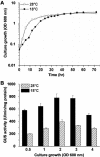NorM, an Erwinia amylovora multidrug efflux pump involved in in vitro competition with other epiphytic bacteria
- PMID: 14766544
- PMCID: PMC348922
- DOI: 10.1128/AEM.70.2.693-703.2004
NorM, an Erwinia amylovora multidrug efflux pump involved in in vitro competition with other epiphytic bacteria
Abstract
Blossoms are important sites of infection for Erwinia amylovora, the causal agent of fire blight of rosaceous plants. Before entering the tissue, the pathogen colonizes the stigmatic surface and has to compete for space and nutrient resources within the epiphytic community. Several epiphytes are capable of synthesizing antibiotics with which they antagonize phytopathogenic bacteria. Here, we report that a multidrug efflux transporter, designated NorM, of E. amylovora confers tolerance to the toxin(s) produced by epiphytic bacteria cocolonizing plant blossoms. According to sequence comparisons, the single-component efflux pump NorM is a member of the multidrug and toxic compound extrusion protein family. The corresponding gene is widely distributed among E. amylovora strains and related plant-associated bacteria. NorM mediated resistance to the hydrophobic cationic compounds norfloxacin, ethidium bromide, and berberine. A norM mutant was constructed and exhibited full virulence on apple rootstock MM 106. However, it was susceptible to antibiotics produced by epiphytes isolated from apple and quince blossoms. The epiphytes were identified as Pantoea agglomerans by 16S rRNA analysis and were isolated from one-third of all trees examined. The promoter activity of norM was twofold greater at 18 degrees C than at 28 degrees C. The lower temperature seems to be beneficial for host infection because of the availability of moisture necessary for movement of the pathogen to the infection sites. Thus, E. amylovora might employ NorM for successful competition with other epiphytic microbes to reach high population densities, particularly at a lower temperature.
Figures







Similar articles
-
Characterization of AcrD, a resistance-nodulation-cell division-type multidrug efflux pump from the fire blight pathogen Erwinia amylovora.BMC Microbiol. 2014 Jan 21;14:13. doi: 10.1186/1471-2180-14-13. BMC Microbiol. 2014. PMID: 24443882 Free PMC article.
-
The phytoalexin-inducible multidrug efflux pump AcrAB contributes to virulence in the fire blight pathogen, Erwinia amylovora.Mol Plant Microbe Interact. 2004 Jan;17(1):43-54. doi: 10.1094/MPMI.2004.17.1.43. Mol Plant Microbe Interact. 2004. PMID: 14714867
-
Conservation of Erwinia amylovora pathogenicity-relevant genes among Erwinia genomes.Arch Microbiol. 2017 Dec;199(10):1335-1344. doi: 10.1007/s00203-017-1409-7. Epub 2017 Jul 10. Arch Microbiol. 2017. PMID: 28695265 Free PMC article.
-
Fire blight: applied genomic insights of the pathogen and host.Annu Rev Phytopathol. 2012;50:475-94. doi: 10.1146/annurev-phyto-081211-172931. Epub 2012 Jun 11. Annu Rev Phytopathol. 2012. PMID: 22702352 Review.
-
Molecular genetics of Erwinia amylovora involved in the development of fire blight.FEMS Microbiol Lett. 2005 Dec 15;253(2):185-92. doi: 10.1016/j.femsle.2005.09.051. Epub 2005 Oct 13. FEMS Microbiol Lett. 2005. PMID: 16253442 Review.
Cited by
-
Bacterial Multidrug Efflux Pumps: Much More Than Antibiotic Resistance Determinants.Microorganisms. 2016 Feb 16;4(1):14. doi: 10.3390/microorganisms4010014. Microorganisms. 2016. PMID: 27681908 Free PMC article. Review.
-
Distinct patterns of natural selection determine sub-population structure in the fire blight pathogen, Erwinia amylovora.Sci Rep. 2019 Sep 30;9(1):14017. doi: 10.1038/s41598-019-50589-z. Sci Rep. 2019. PMID: 31570749 Free PMC article.
-
Characterization of the RND-type multidrug efflux pump MexAB-OprM of the plant pathogen Pseudomonas syringae.Appl Environ Microbiol. 2008 Jun;74(11):3387-93. doi: 10.1128/AEM.02866-07. Epub 2008 Apr 4. Appl Environ Microbiol. 2008. PMID: 18390672 Free PMC article.
-
RNA-Seq reveals that Pseudomonas aeruginosa mounts growth medium-dependent competitive responses when sensing diffusible cues from Burkholderia cenocepacia.Commun Biol. 2024 Aug 14;7(1):995. doi: 10.1038/s42003-024-06618-3. Commun Biol. 2024. PMID: 39143311 Free PMC article.
-
A Helicobacter pylori TolC efflux pump confers resistance to metronidazole.Antimicrob Agents Chemother. 2005 Apr;49(4):1477-82. doi: 10.1128/AAC.49.4.1477-1482.2005. Antimicrob Agents Chemother. 2005. PMID: 15793129 Free PMC article.
References
-
- Bengoechea, J. A., and M. Skurnik. 2000. Temperature-regulated efflux pump/potassium antiporter system mediates resistance to cationic antimicrobial peptides in Yersinia. Mol. Microbiol. 37:67-80. - PubMed
-
- Billing, E. 1980. Fireblight (Erwinia amylovora) and weather: a comparison of warning systems. Ann. Appl. Biol. 95:365-377.
-
- Blackmore, C. G., P. A. McNaughton, and H. W. van Veen. 2001. Multi-drug transporters in prokaryotic and eukaryotic cells: physiological functions and transport mechanisms. Mol. Membr. Biol. 18:97-103. - PubMed
-
- Brown, M. H., I. T. Paulsen, and R. A. Skurray. 1999. The multi-drug efflux protein NorM is a prototype of a new family of transporters. Mol. Microbiol. 31:394-395. - PubMed
Publication types
MeSH terms
Substances
Associated data
- Actions
LinkOut - more resources
Full Text Sources
Molecular Biology Databases

